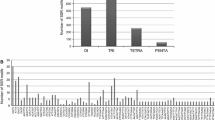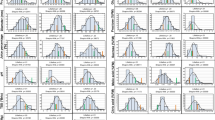Abstract
Inheritance and linkage relationships of several morphological and isozyme loci are described in chickpea (Cicer arietinum L.). Segregation data obtained from several F2 families confirmed the previously observed mode of inheritance for most of the morphological loci. Additional morphological markers in chickpea are also described. Most of the isozyme loci studied showed codominant expression and fit expected Mendelian segregation ratios. However, distorted ratios were also observed for some loci. Linkage was found betweenPgd-c, the locus encoding the cytosolic form of 6-phosphogluconate dehydrogenase, andHg, the locus controlling plant growth habit. These 2 loci were separated by approximately 18 recombinational map units. A similar linkage between comparable loci was previously reported in pea (Pisum sativum L.) (Weeden and Wolko 1990). Linkage was also detected among 3 isozyme loci; the cytosolic form of phosphoglucomutase (Pgm-c), glucose-1-phosphate transferase (Gpt1), and the plastid specific form of 6-phosphogluconate dehydrogenase (Pgd-p). The linkage of 2 loci (Pgm-c andPgd-p) in this cluster is also conserved in pea and lentil (Lens Miller). The linkage between an acid phosphatase locus (Acp3) and the locus specifying the cytosolic form of glucosephosphate isomerase (Gpi-c) in chickpea suggested another linkage group in common with pea. Additionally, other linkages that were not previously observed in chickpea or related genera included the linkage of the cytosolic form of aconitase (Aco-c) with adenylate kinase (Adk1) and fructokinase (Fk3), and the linkage of a locus encoding the mitochondrial specific aconitase (Aco-m) with a seed protein locus (Spr1). The loci determining flower color (P), epicotyl color (Gst), seed coat color (T 3), and seed surface (Rs) were associated with the locus encoding glucose-1-phosphate transferase (Gpt2). These results, along with previous studies, suggest that pea, lentil and chickpea have several common linkage groups consisting of homologous genes. This also indicates that linkages found in one genus can be used to predict similar linkages in related genera in the development of linkage maps.
Similar content being viewed by others
References
Ainsworth CC, Johnson HM, Jackson EA, Miller TE, Gale MD (1984) The chromosomal locations of leaf peroxidase genes in hexaploid wheat, rye and barley. Theor Appl Genet 69:205–210
Ainsworth CC, Miller TE, Gale MD (1986) The genetic control of grain esterases in hexaploid wheat. 2. Homoeologous loci in related species. Theor Appl Genet 72:219–225
Argikar GP (1952) Some unreported mutations inCicer arietinum L. J Indian Bot Soc 31:362–369
Argikar GP, D'Cruz R (1962) Inheritance of foliage, cotyledon and testa color inCicer. Indian J Genet Plant Breed 22:241–243
Argikar GP, D'Cruz R (1963) Genetic studies in gram. J Indian Bot Soc 42:401–405
Athwal DS, Brar HS (1967) Inheritance of flower color and its relationship with some mutant loci inCicer. Indian J Genet Plant Breed 27:21–33
Bhapkar DG, Patil JA (1963) Inheritance of foliage, flower and seed coat colors in gram. Crop Sci 3:361
Cardy BJ, Beversdorf WD (1984) A procedure for the starch gel electrophoretic detection of isozymes of soybean [Glycine max (L.). Merr.]. Tech Bull No. 119/8401. Dept of Crop Sci University of Guelph, Ontario, Canada
Cardy BJ, Stuber CW, Goodman MM (1980) Techniques for starch gel electrophoresis of enzymes from maize (Zea mays L.) NC State Univ Dep Stat Mimeo Ser No. 1317, Raleigh N.C.
Clayton JW, Tretiak DN (1972) Amine-citrate buffers for pH control in starch gel electrophoresis. J Fish Res Board Can 29:1169–1172
Coe EH, Hoisington DA, Neuffer MG (1990) Linkage map of corn (maize) (Zea mays L.). In: O'Brien SJ (ed) Genetic maps, book 6: plants. Cold Spring Harbor Laboratory Press, Cold Spring Harbor, N.Y., pp 6.39–6.67
Darby P, Lewis BG, Matthews P (1985) Inheritance and expression of resistance ofAscochyta pisi. In: Hebbletwaith PD, Heath MC, Dawkins TCK (eds) The pea crop, a basis for improvement. Butterworths, London, pp 231–236
Davis TM (1988) Two genes that confer ineffective nodulation in chickpea (Cicer arietinum L.). J Hered 79:476–478
Davis TM, Foster KW, Phillips DA (1985) Nodulation mutants in chickpea. Crop Sci 25:345–348
Davis TM, Foster KW, Philips DA (1986) Inheritance and expression of three genes controlling root nodule formation in chickpea. Crop Sci 26:719–723
Davis TM, Matthews LJ, Fagerberg WR (1990) Comparison of tetraploid and single gene-induced gigas variants in chickpea (Cicer arietinum). I. Origin and genetic characterization Am J Bot 77:295–299
Gaur PM, Slinkard AE (1990) Genetic control and linkage relations of additional isozyme markers in chick-pea. Theor Appl Genet 80:648–656
Hart GE, Gale MD (1990) Biochemical/molecular loci of hexaploid wheat. In: O'Brien SJ (ed) Genetic maps, book 6: plants, Cold Spring Harbor Laboratory Press, Cold Spring Harbor, N.Y., pp 628–638
Havey MJ, Muehlbauer FJ (1989) Linkages between restriction fragment length, isozyme, and morphological markers in lentil. Theor Appl Genet 77:395–401
Kazan K, Muehlbauer FJ, Weeden NF (1991) Duplication of aldolase and esterase loci inCicer (Cicer arietinum L.). J Hered 82:58–63
Kesseli RV, Paran I, Michelmore RV (1990) Genetic linkage map of lettuce (Lactuca sativa L.). In: O'Brien SJ (ed) Genetic maps, book 6: plants. Cold Spring Harbor Laboratory Press, Cold Spring Harbor, N.Y., pp. 6.100–6.102
Koenig R, Gepts P (1989) Segregation and linkage of genes for seed proteins, isozymes, and morphological traits in common bean (Phaseolus vulgaris). J Hered 80:455–459
Kusmenoglu I, Muehlbauer FJ, Kaiser WJ (1989) Inheritance of Ascochyta blight and relationship to seed size in chickpea. Agron Abstr Am Soc Agron, p 89
Ladizinsky G (1979) The genetics of several morphological traits in the lentil. J Hered 70:135–137
Ladizinsky G, Adler A (1976) Genetic relationships among annual species ofCicer L. Theor Appl Genet 48:197–203
Lamm R (1951) Cytogenetical studies on translocations inPisum. Hereditas 42:737–744
McMillin DE, Allan RE, Roberts DE (1986) Association of an isozyme locus and strawbreaker foot rot resistance derived fromAegilops ventricosa in wheat. Theor Appl Genet 72:743–747
McMullen MD, Lovie R (1989) The linkage of molecular markers to a gene controlling the symptom response in maize to maize dwarf mosaic virus. Mol Plant Microbe Int 2:309–314
More DC, D'Cruz R (1970) Genetic studies in Bengal gram (Cicer arietinum L.). Poona Agric Coll Mag 60:27–32
Moreno MT, Cubero JI (1978) Variation inCicer arietinum L. Euphytica 27:465–485
Muehlbauer FJ, Singh KB (1987) Genetics of chickpea. In: Saxena MC, Singh KB (eds) The chickpea. CAB Int London, pp 99–125
Muehlbauer FJ, Weeden NF, Hoffman DL (1989) Inheritance and linkage relationships of morphological and isozyme loci in lentil (Lens Miller). J Hered 80:293–303
Nichols EA, Ruddle FH (1973) A review of enzyme polymorphism, linkage and electrophoretic conditions for mouse and somatic cell hybrids in starch gels. J Histochem Cytochem 21:1066–1081
Oram RN, Shaikh MAQ, Zaman KMS, Brown AHD (1987) Isozyme similarity and genetic differences in morphology between Hyprosola, a high yielding, high protein mutant of chickpea. Environ Exp Bot 27:455–462
Palmer RG, Kiang YT (1990) Linkage map of soybean (Glycine Max L. Merr.). In: O'Brien SJ (ed) Genetic maps, book 6: plants. Cold Spring Harbor Laboratory Press, Cold Spring Harbor, N.Y., pp 6.68–6.93
Pawar AM, Patil JA (1983) Genetic studies in gram. J Maharashta Agric Univ 8:54–56
Pundir RPS, van der Maesen LJG (1981) A spontaneous polycarpellary mutant in chickpea (Cicer arietinum L.). Int Chickpea Newsl 5:2–3
Pundir RPS, Mengesha MH, Reddy KN (1988) Occurrence and genetics of a natural mutant of chickpea having twin flower peduncles and polycarpy. J Hered 79:6
Rao NK, Pundir RPS (1983) Inheritance and linkage relationships of a new lobed vexillum mutant of chickpea. J Hered 74:300
Rao NK, Pundir RPS, van der Maesen LJG (1980) Inheritance of some qualitative characters in chickpea (Cicer arietinum L.). Proc Indian Acad Sci 89:497–503
Rick CM, Fobes JF (1974) Association of an allozyme with nematode resistance. Rep Tomato Genet Coop 24:25
Salinas J, Figuerias AM, Gonzales-Jaen MT, Benito C (1984) Chromosomal location of isozyme markers in wheat-barley addition lines. Theor Appl Genet 70:192–198
Sarfatti M, Katan J, Fluhr R, Zamir D (1989) An RFLP marker in tomato linked toFusarium oxysporum resistance gene 12. Theor Appl Genet 78:755–759
Selander RK, Smith MH, Yang SY, Johnson WE, Gentry JB (1971) Biochemical polymorphism and systematics in the genus peromyscus. I. Variation in the old-field mouse (Peromyscus polionotus). Univ Texas Publ 7103:49–90
Singh B (1962) Inheritance studies of a new spontaneously originated simple leaf mutant inCicer arietinum L. Sci and Cult 28:138–139
Soltis De, Haufler CH, Darrow DC, Gastony GJ (1983) Starch gel electrophoresis of ferns: a compilation of grinding buffers and staining schedules. Am Fern J 73:9–27
Suiter KA, Wendel JF, Case JS (1983) LINKAGE-1:a PASCAL computer program for the detection and analysis of genetic linkage. J Hered 74:203–204
Tadmor Y, Zamir D, Ladizinsky G (1987) Genetic mapping of an ancient translocation in the genusLens. Theor Appl Genet 73:883–892
Tanksley SD (1984) Linkage relationships and chromosomal location of enzyme coding genes in pepper,Capsicum annuum. Chromosoma 89:352–360
Tanksley SD, Mutschler MA (1990) Linkage map of tomato (Lycopersicum esculentum L.). In: O'Brien SJ (ed) Genetic maps, book 6: plants. Cold Spring Harbor Laboratory Press, Cold Spring Harbor, N.Y., pp 6.13–6.13
Tuwafe S, Kahler AL, Boe A, Ferguson M (1988) Inheritance and geographical distribution of allozyme polymorphisms in chickpeaCicer arietinum L. J. Hered 79:170–174
Weeden NF (1988) A suggestion for the nomenclature of isozyme loci. Pisum Newsl 20:44–45
Weeden NF, Gottlieb LD (1980) Isolation of cytoplasmic enzymes from pollen. Plant Physiol 66:400–403
Weeden NF, Marx GA (1984) Chromosomal locations of twelve isozyme loci inPisum sativum. J Hered 75:365–370
Weeden NF, Marx GA (1987) Further genetic analysis and linkage relationships of isozyme loci in the pea: confirmation of the diploid nature of the genome. J Hered 78:153–159
Weeden NF, Provvidenti R (1987) A marker locus,Adh-1, for resistance to pea enation mosaic virus. Pisum Newsl 19:82–83
Weeden NF, Wolko B (1990) Linkage map for the garden pea (Pisum sativum) based on molecular markers. In: O'Brien SJ (ed) Genetic maps, book 6: plants. Cold Spring Harbor Laboratory Press, Cold Spring Harbor, N.Y., pp 6.106–6.112
Weeden NF, Provvidenti R, Marx GA (1984) An isozyme marker for resistance to bean yellow mosaic virus inPisum sativum. J Hered 75:411–412
Weeden NF, Zamir D, Tadmor Y (1988) Application of isozyme analysis in pulse crops. In: Summerfield RJ (ed) World crops:cool season food legumes Kluwer Academic Publ. pp 979–987
Zamir D, Ladizinsky G (1984) Genetics of allozyme variants and linkage groups in lentil. Euphytica 33:329–336
Zamir D, Tadmor Y (1986) Unequal segregation of nuclear genes in plants. Bot Gaz 147:355–358
Author information
Authors and Affiliations
Additional information
Communicated by A. L. Kahler
Rights and permissions
About this article
Cite this article
Kazan, K., Muehlbauer, F.J., Weeden, N.E. et al. Inheritance and linkage relationships of morphological and isozyme loci in chickpea (Cicer arietinum L.). Theoret. Appl. Genetics 86, 417–426 (1993). https://doi.org/10.1007/BF00838556
Received:
Accepted:
Issue Date:
DOI: https://doi.org/10.1007/BF00838556




